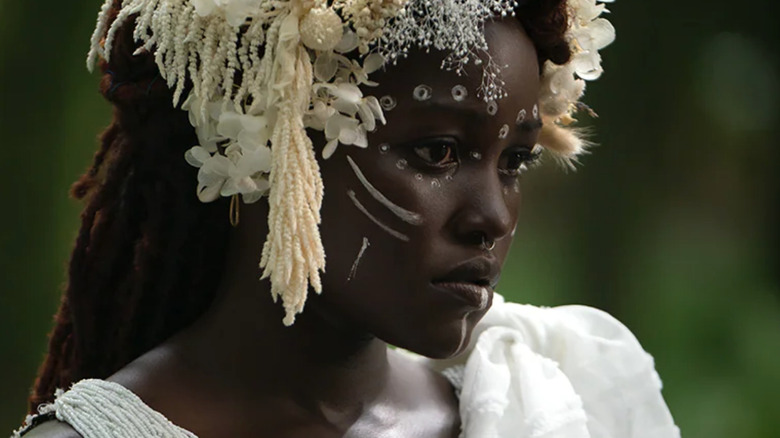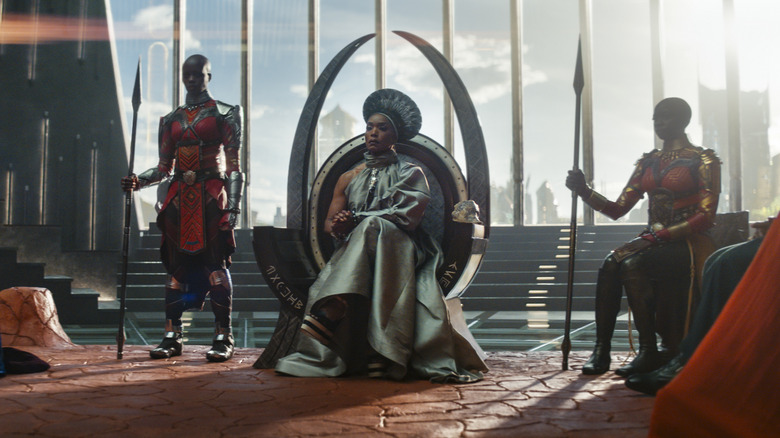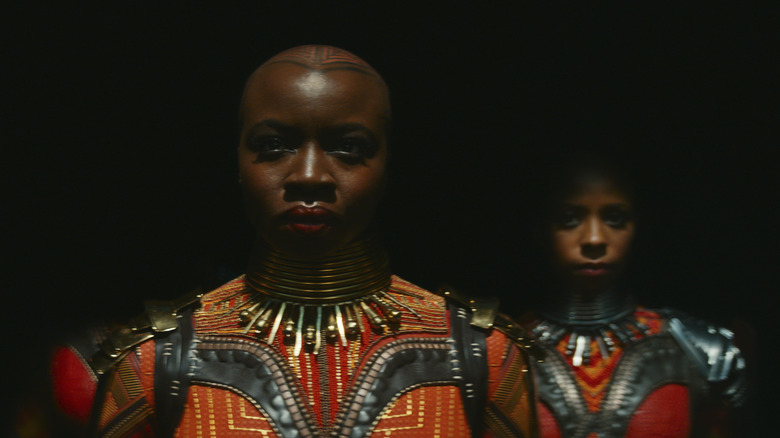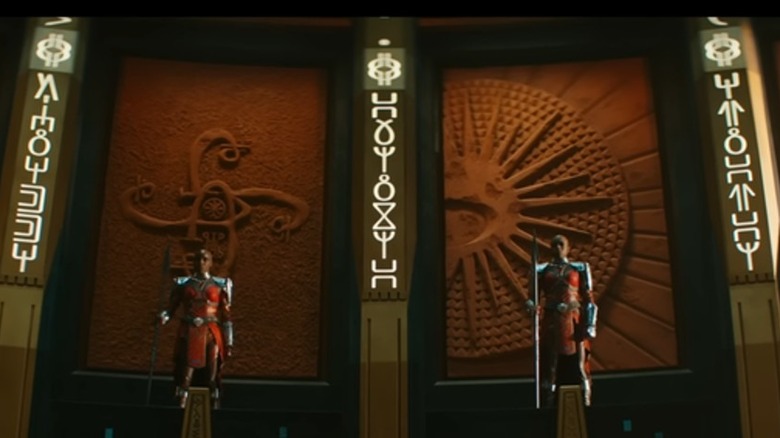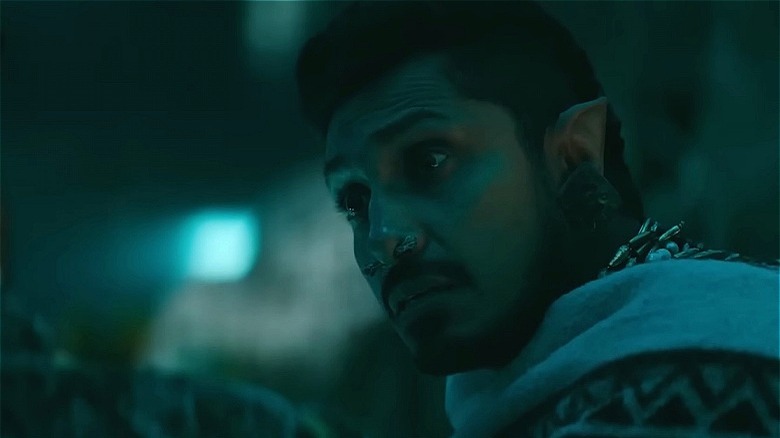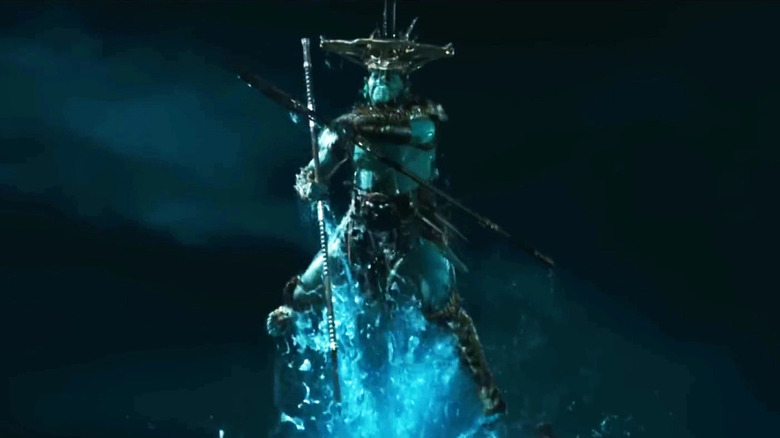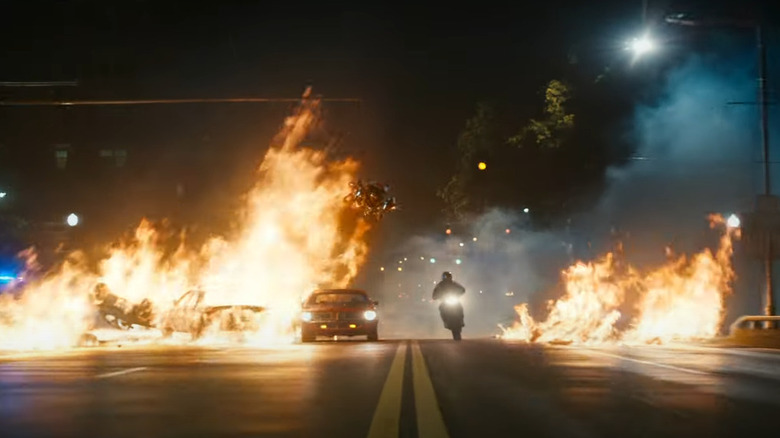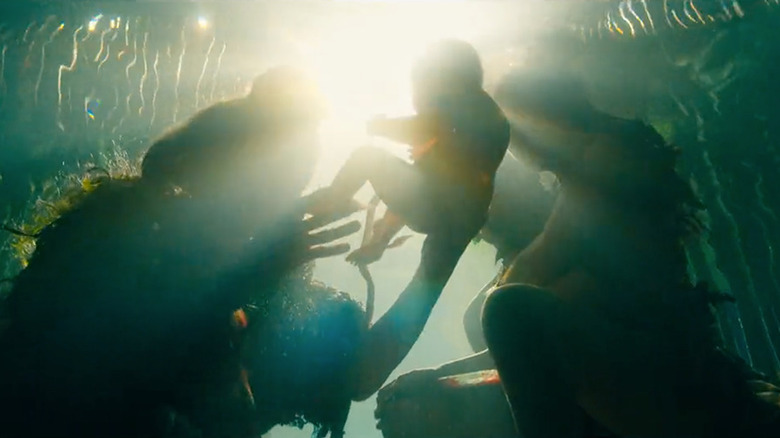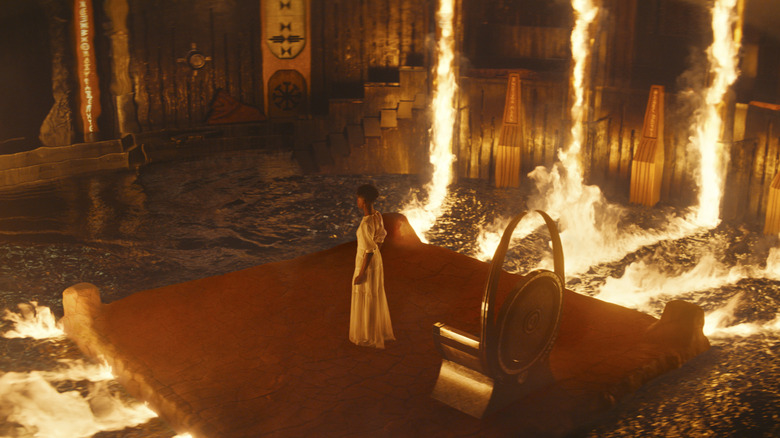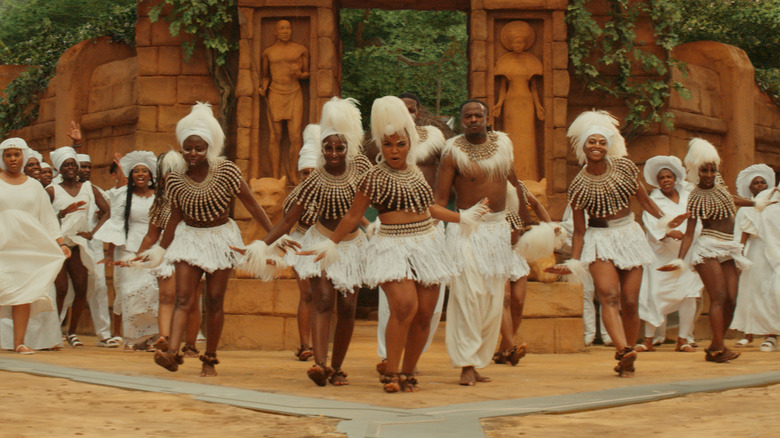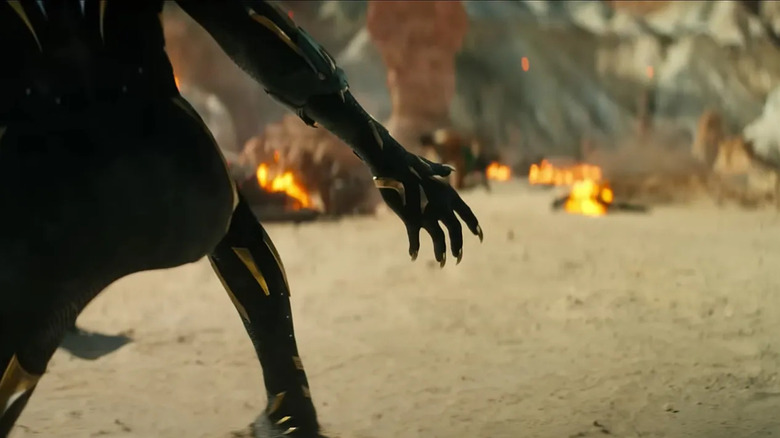Black Panther: Wakanda Forever's Most Pause-Worthy Moments Ranked
Contains spoilers for "Black Panther: Wakanda Forever"
It can be difficult for a sequel to distinguish itself from the original, especially when the original is one of the most successful and culturally resonant films of all time. The entire MCU is facing that problem post-"Avengers: Endgame" as the mega-franchise and its handlers try to figure out whether to go bigger (like, gods and the cosmos big) or smaller, with more personal stories and stakes. In some ways, "Black Panther: Wakanda Forever" leans into a more-is-more philosophy. The much-anticipated follow-up clocks in at two hours and 41 minutes, making it the second longest of all 30 MCU movies, ranking just behind the "Endgame" runtime of three hours and one minute. "Wakanda Forever" is also a story of worlds colliding. It introduces an entirely new civilization in Talokan, whose god king is the film's anti-hero, Namor (Tenoch Huerta). The visual effects, the costumes, the music ... it's all a feast for the senses.
But "Wakanda Forever" is also an intimate tale of grief, anger, and fear. As captivating as its car chases and combat choreography are, it shines just as brightly in its less action-packed but still intense moments, when two characters are talking, or even when one person just sits silently. And, whether it's going big or small, it all looks great. One of the areas where "Wakanda Forever" might actually improve on its roundly praised predecessor is in its ambitious production design and more realistic CGI. From grand entrances to fresh-looking fight scenes, from unexpected cameos to fitting tributes to the late Chadwick Boseman, these are the moments in "Black Panther: Wakanda Forever" that dropped our jaws and stopped us in our tracks.
10. Queen Ramonda commands the room
Okay, so this is cheating, but practically every moment Angela Bassett is on screen as Queen Ramonda is worthy of a pause. Angela Bassett — the stunningly beautiful elder stateswoman of the cast of "Wakanda Forever" — is a believably regal presence who keeps it real on the throne and in the halls of the United Nations. But it's the combination of Bassett's poise and the impossibly gorgeous costumes that Ruth E. Carter designed for the character that makes every frame of Queen Ramonda a work of art. Let's be honest; all of Carter's costumes are top-notch, but Ramonda gets the best clothes, and it's not even close. Every one is a statement piece, and that statement is, "I'm the most important person in the room."
Each outfit is precisely detailed, sumptuously textured, and unique, but with motifs and patterns that run throughout her whole lookbook. Her dresses are usually made of shiny, billowing fabrics adorned with overlays of intricate metalwork pieces. They reference Wakanda's traditions and its scientific advancements. They move well, they photograph well, and they suit the character's elevated stature. Whether she's done up in formalwear and donning her traditional isicholo hat or keeping it loose in casual wear and letting her gray hair flow free, Ramonda commands the screen. If we have to pick one showstopper, it's probably the dramatic plum and gold number she wears to call out America and the French.
9. The Dora Milaje crash the UN
Speaking of the United Nations, two of the Dora Milaje's best moments happen before and after Queen Ramonda's testimony. French covert operatives are attempting to steal and study vibranium while the nation itself is calling for stricter oversight measures against Wakanda on the world stage. But the Dora Milaje have a woman on the inside ... and several more fully armored women on the outside, as it turns out. Okoye (Danai Gurira) and her warriors make their slow-motion, uber-confident entrance as Aneka (Michaela Coel) drops her undercover persona and joins the fight. That scene speaks to Wakanda's own intelligence capabilities, and it features some of the most dynamic action we've seen the Dora Milaje engaged in so far.
A second Dora Milaje scene that bookend's the United Nation's hearing is the international affairs equivalent of a mic drop. Just as France and the U.S. are arguing against Wakanda's right to possess and control vibranium without oversight, Okoye and squad burst through the hall's doors with the French special ops subdued and in their custody. The Wakandans have successfully demonstrated the rest of the world's hypocrisy when it comes to weapons of mass destruction and their tiny but powerful nation, and they looked cool doing it. The Dora Milaje in their bold red and leather uniforms standing righteously over the cowering French in their fatigues makes for one heck of a plot development and one heck of a shot composition.
8. Riri sees Wakanda for the first time
When Nakia (Lupita Nyong'o) rescues Shuri (Letitia Wright) and Riri Williams (Dominique Thorne) at the behest of Queen Ramonda, she inadvertently sets off a war between Wakanda and Talokan. But before Namor and his people flood the streets, there's time for Riri to take in her surroundings. The MIT student and super genius is not only familiar with the secretive African nation, but she recognizes Princess Shuri at first glance and is obviously a fan of her work. Why wouldn't she be? She's young, Black, and talented as she points out, which is less of a calling card in Wakanda than it is in Boston.
It's fun to watch the tech- and Avengers-obsessed Riri realize she's been absconded to what would basically be her Mecca. We see the inside of Wakanda's most sacred places, including its research facilities, from her perspective. As we've come to expect from a "Black Panther" movie, these sets are expertly imagined and crafted. They build on production designer Hannah Beachler's previous Oscar-winning work, which blends Afrofuturism and Egyptian mythology with the MCU's signature style. But in one stately room in particular, there's an extra layer of meaning.
The Dora Milaje stand guard among five columns, all lit from within. Each column is decorated with Wakandan letters (Beachler designed an actual alphabet for "Black Panther"), stacked vertically. Translated to English, as a fan on Twitter observed, these columns appear to read: In power, T'Challa, our hero, an honor, forever.
7. Shuri sees Talokan for the first time
Riri might've been in awe of Wakanda, but at least she was aware it existed. Shuri had no idea there was an entire civilization hundreds of feet below the surface of the ocean, rich with its own vibranium deposits. In a scene that's sure to draw comparisons to "Avatar: The Way of Water," Namor outfits Shuri with a diving suit and takes her to his home world of Talokan. Just as she did with Wakanda, Hannah Beachler brought the MCU's new and improved version of Atlantis to life with influences from Mesoamerican history and mythology.
The Wakandan Princess's reverse "Little Mermaid" situation benefits from the palpable tension and chemistry between Letitia Wright's Shuri and Tenoch Huerta's Namor. But it's also made more magical by the way the underwater city slowly reveals itself. At first, Shuri can only make out faint light in the distance through the water. Gradually, her eyes begin to focus on the kingdom and its people. Shuri's astounded by what Namor has been able to create over the centuries (she deduces from his origin story that he's a little older than he looks). Talokan, which has its own vibranium-powered sun, is a paradise and refuge for Namor's people, who've already been driven from their territory at least once. The highlight of this scene is the moment Namor tells Shuri she's the first person from the surface to ever see this otherwise undiscovered watery dream world, just as the full beautiful picture of Talokan comes into focus.
6. Attuma makes a splash
The prologue, opening credits, and first act of "Wakanda Forever" all deal with the death of T'Challa (Chadwick Boseman) and are, as a result, moving but melancholy. But the mood changes when a CIA-led research team is ambushed on the deck of their massive base vessel. The set piece plays out like a dark water horror movie, and the audience knows something is amiss before the characters do. Panic sets in when one of the divers goes missing; a flashlight shines upon his severed, frayed cable. Seconds later, a hunky blue humanoid bursts out of the water and onto the deck without warning. The frame rate slows so we can get a better look at the aggressor.
This isn't Namor. It's Attuma (Alex Livinalli), one of his chief adversaries in the comics. In "Wakanda Forever," he's used as a brutish underling. It's an interesting choice to lead with Attuma and save Namor's reveal, and it's probably the right one. Namor — who's more of an Aztec god king than Marvel Comics' traditional Sub-Mariner — gets more buildup, plus a more mythical and memorable debut shortly thereafter when he emerges from the water's edge with a conch shell to negotiate with Queen Ramonda and Shuri. But the sketchy CIA mission gone awry is the film's first dose of adrenaline, and nothing will make you jump in a helicopter and call for backup like the sight of this shredded Talokanil coming after you, spears akimbo.
5. The triple-vehicle escape
Almost every MCU film comes standard with a car chase. "Black Panther" had one of the best, an innovative race through the streets of Busan during which Shuri drives a Lexus remotely as a suited-up T'Challa leaps and scrapes between vehicles and the road. "Wakanda Forever's" version, which takes place in Boston, isn't quite as stylish or thrilling, though it's still a well-staged bit of spectacle.
When the feds show up at Riri's friend's garage — where she keeps her research, her prototypes, and her classic car — the 19-year-old MIT student has no choice but to flee with Shuri and Okoye. Okoye takes the car, Shuri hops onto a motorcycle, and Riri climbs into what we can assume is the Mark 1 of her Ironheart suit, made of auto parts. The chase itself isn't very long, but it harkens back to daring stunts from the MCU's past, including the one in "Black Panther" (Okoye's back to using spears on cars again), early Iron Man (Robert Downey Jr.) flight sequences, and T'Challa's pursuit of Bucky (Sebastian Stan) in "Captain America: Civil War."
But there's something that makes this chase scene special. The "Black Panther" movies rightly get attention for their majority Black casts, but they don't get enough credit for their majority female characters. When the frame freezes on Shuri, Okoye, and Riri in their kinetic poses, we realize how rare it is and how awesome it looks to see three capable women in the middle of the action.
4. Young Namor conquers the conquerors
The positive reception to Michael B. Jordan's Erik Killmonger proved that MCU audiences like to like their villains. "Wakanda Forever" continues that trend with Namor, an anti-hero with an updated backstory that almost makes us want to root for him, even when he's killing off main characters we also love. The film tells us his origin story in flashback while he narrates the curious and tragic tale to Shuri. His mother's people ingested their native vibranium-enhanced plants, but instead of giving them the strength of the panther, it sent them into the sea. Namor, who was still in his mother's womb, was born a mutant as a result. Though their civilization began to thrive underwater, his mother longed for the normal human life that the invaders and the herb had taken away from her. Upon her death, Namor promises he'll bury her in the land she loved.
But when it's time for him to keep that promise, the grieving child finds that conquerors have ravaged her country and will slaughter every indigenous person — blue or otherwise — in sight. He taps into his mutant superpowers to set fire to their colony and quell their attack. This earns him his people's adoration and the name K'uk'ulkan (or the Feathered Serpent God). But the colonizers view him as a monster and call him a boy without love ("no amor," which begets his name, Namor). He takes both names as a source of pride. The haunting twin shots in which the Spanish oppressors scatter amidst the flames as a vengeful young Namor watches everything burn establish the MCU's latest complex character as equally sympathetic and scary.
3. Shuri's ancestral plane surprise
Fans of Erik Killmonger (Michael B. Jordan), of whom there are many, hoped the character might make an appearance in "Wakanda Forever." But as the film hurdled toward its conclusion with only a stray mention of T'Challa's dead cousin and foe, those hopes began to fade. Then, just when audiences (who weren't spoiled) least expected it, Killmonger shows up in one of the MCU's most thoughtful and effective cameos to date.
After Shuri produces a 99%-effective, lab-created Heart-Shaped Herb, she tests it on herself. Instead of a traditional ceremony, the Princess just wants someone to monitor her vitals with Kimoyo beads. "Wakanda Forever" is able to pull off this surprise because Shuri doesn't expect to see anyone when she reaches the ancestral plane, if she reaches it at all. It's heavily implied she's a nonbeliever in the afterlife, which is why she's struggling so much with T'Challa's death. She's overwhelmed and disoriented when she comes to and sees that the spiritual realm is real, then she (and we) see the back of her family's throne. She calls out for her mother, father, and brother, but instead she finds the last person she expected to meet in some version of heaven: Killmonger. They have a brutally honest conversation that becomes a turning point for Shuri. It's one of the stand-out scenes in the movie, but the moment we realize who's on the throne is what we'll remember.
2. Wakanda celebrate's T'Challa's life
Marvel movies are, of course superhero stories and comic book adaptations. Writers, directors, cinematographers, editors, designers, and actors know going in that choreographed fights, quippy dialogue, Easter eggs, and CGI explosions are part of the deal. To be sure, the excess and the exhilaration are part of what make the genre so popular. But with "Black Panther: Wakanda Forever," the cast and crew were given the opportunity to do something more restrained and contemplative, especially in the first and last scenes.
T'Challa dies not at the hands of the enemy or in some convoluted plot twist, but from illness. As the character told us about his own father's passing, "In my culture, death is not the end. It's more of a stepping off point. You reach out with both hands and Bast and Sekhmet, they lead you into a green veld where you can run forever." To mourn, honor, and celebrate this step in the king's journey (and Boseman's), the filmmakers have orchestrated a moving and magnificent Wakandan funeral worthy of the character and the actor. Every aspect — the attire, the music, the joyous dancing, the somber preparation of the casket — is perfectly rendered. But one of the most emotional images of this or any Marvel movie is the moment the camera pulls wide to show the entire nation of Wakanda dressed in white and paying its respects.
1. The new Black Panther leads her people
"Wakanda Forever" ends as Shuri burns her funeral garb to symbolize that she's processed T'Challa's death. As the fibers go up in flames, she closes her eyes and remembers her brother as we remember him, in a series of his greatest moments from the MCU. The most indelible of these are the times T'Challa stands at the vanguard of his forces — be they Wakandans or the Avengers assembled — and crosses his arms over his chest to proclaim "Wakanda forever." It's only fitting that Shuri, the new Black Panther, should get a moment like this of her own. Her chance comes, as one might expect, when she's about to lead her army into battle against Namor and the Talokanil.
It's not the first time we see Shuri in her version of the vibranium-reinforced super suit. That happens when she repels down into M'Baku's mountain layer and stands before the gathered refugees to announce that, since she's been able to replicate the Heart-Shaped Herb, Wakanda has its protector again. Her people look on with astonishment and renewed hope, which lets the viewers get a good long look at Shuri's unique Black Panther costume.
The still that will end up on posters and lunchboxes, however, and that one that rouses audiences from their subdued reflection on this movie's serious themes, is the frame of Shuri — without her mask on — standing front and center at the bow of the ship, her people in formation behind her. This is the moment that feels like the Black Panther is truly back.
